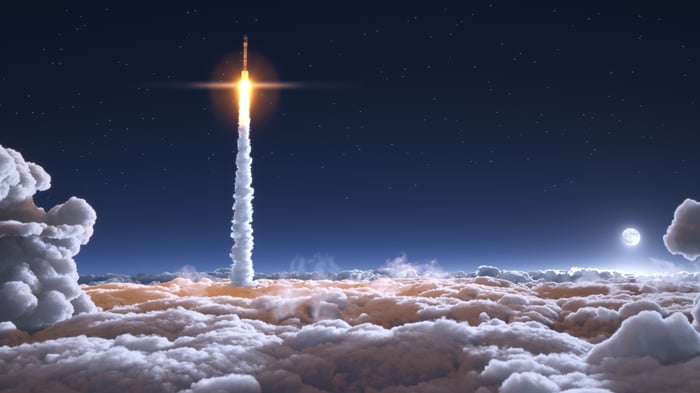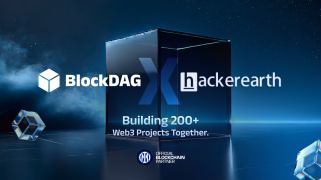KEY POINTS
- On Nov. 18, SpaceX blew up another Starship spaceship and its Super Heavy booster -- but that's just the start of the story.
- SpaceX got Starship to fly twice as long as last time in Saturday's test flight.
- At this point, regulatory delays may be the biggest obstacle to SpaceX doubling Starship's flight time all the way to 100% success.
Starship is getting better and better with each test flight -- and other space companies should be nervous.
Oops. It looks like SpaceX needs to build another Starship.
要点 11 月 18 日,SpaceX 炸毁了另一艘 Starship 宇宙飞船及其超重型助推器——但这只是故事的开始。在周六的试飞中,SpaceX 让 Starship 的飞行时间是上次的两倍。此时,监管方面的延误可能是 SpaceX 将 Starship 飞行时间加倍直至 100% 成功的最大障碍。Starship 每次试飞都变得越来越好——其他航天公司应该感到紧张。哎呀。看起来 SpaceX 需要建造另一艘星际飞船。
On Saturday, SpaceX conducted its second-ever flight test of its Starship prototype interplanetary spaceship atop a Super Heavy booster rocket. And as multiple news outlets reported, it ended in disaster:
周六,SpaceX 在超重型助推火箭上对其 Starship 原型星际飞船进行了第二次飞行测试。正如多家新闻媒体报道的那样,它以灾难告终:
"Starship test launch ends in explosions" (CBS).
“星舰试射以爆炸告终”(哥伦比亚广播公司)。
"Starship launch failed minutes after reaching space" (Reuters).
“星舰在到达太空几分钟后发射失败”(路透社)。
"Starship achieves liftoff and separation, but 'mishap' results in loss of rocket" (NBC).
“星舰实现升空和分离,但‘事故’导致火箭丢失”(NBC)。

IMAGE SOURCE: GETTY IMAGES.
图片来源:盖蒂图片社。
Starship blew up. So did Super Heavy.
After launching from its pad near Boca Chica, Texas, at 8:02 a.m. ET on Saturday, Nov.18, SpaceX's booster exploded midflight about three and a half minutes after takeoff. Less than five minutes later, the Starship experienced its own "rapid unscheduled disassembly," apparently in response to an onboard self-destruct command.
星舰爆炸了。 Super Heavy 也是如此。 美国东部时间 11 月 18 日星期六上午 8 点 02 分,SpaceX 的助推器在德克萨斯州博卡奇卡附近的发射台发射升空,起飞后约三分半钟,在飞行途中爆炸。不到五分钟后,星舰经历了“快速的计划外拆卸”,显然是为了响应舰上的自毁命令。
But that doesn't mean the mission was a failure. Far from it.
但这并不意味着任务失败。离得很远。
The rest of the story
Yes, there were some big, Technicolor explosions, delivered in full Dolby surround sound. But SpaceX's Starship test flight last weekend also scored multiple successes:
故事的其余部分是的,有一些大型的彩色爆炸,以完整的杜比环绕声呈现。但 SpaceX 上周末的 Starship 试飞也取得了多项成功:
New launch pad technology muffled sound vibrations, and minimized damage to the pad. This greatly improved over April's test, when Super Heavy more or less destroyed its own pad in the process of launching from it.
新的发射台技术可消除声音振动,并最大限度地减少对发射台的损坏。这比四月份的测试有了很大改进,当时超重型在发射过程中或多或少摧毁了自己的发射台。
All 33 Raptor engines on the Super Heavy Booster lit and stayed lit throughout the first stage's flight. This improved over April's test flight performance, when three engines flamed out.
超重型助推器上的所有 33 个猛禽发动机都点亮并在第一阶段的飞行过程中一直保持点亮状态。这比四月份的试飞性能有所改善,当时三台发动机熄火。
SpaceX proved the concept of "hot-stage separation," in which Starship's six engines lit while Super Heavy was still "on." Starship then powered away from Super Heavy while the latter turned off 30 of its 33 engines, and executed its patented flip-and-boostback maneuver to position itself for relanding back on Earth.
SpaceX 证明了“热阶段分离”的概念,其中星际飞船的六个发动机点燃,而超级重型仍然“开启”。随后,星舰脱离超重型发动机,而超重型发动机关闭了 33 个发动机中的 30 个,并执行了其获得专利的翻转和助推机动,以重新着陆地球。
Starship itself then rocketed past the Karman line to space, getting to about 90 miles above the Earth before self-destructing.
随后,星舰本身飞速冲过卡门线,飞向太空,到达距地球约 90 英里的高度,然后自毁。
And with test flight 2 in the books, SpaceX is already getting ready for test flight No. 3. As CEO Elon Musk quickly confirmed, SpaceX will be ready to improve on last week's performance in less than one month, FAA permitting:
随着第二次试飞的完成,SpaceX 已经为第三次试飞做好了准备。正如首席执行官埃隆·马斯克 (Elon Musk) 很快证实的那样,在美国联邦航空局 (FAA) 允许的情况下,SpaceX 将在不到一个月的时间内准备好改善上周的表现:
Countdown to 100% success
Of course, that's the real rub. The fact that Starship and Super Heavy weren't 100% successful last week means the Federal Aviation Administration will want to do another "mishap" investigation before allowing SpaceX to try again. And it took the FAA seven months after test flight 1 to OK test flight 2. If it has to wait seven more months for test flight No. 3 -- and for each test flight thereafter -- then things could start to get tricky for SpaceX as it races to get Starship ready to perform a moon landing for NASA under the latter's Project Artemis.
100% 成功倒计时 当然,这才是真正的难题。上周 Starship 和 Super Heavy 并未 100% 成功,这意味着美国联邦航空管理局将希望在允许 SpaceX 再次尝试之前进行另一次“事故”调查。从第一次试飞到第二次试飞,美国联邦航空局花了七个月的时间。如果第三次试飞以及此后的每次试飞还需要再等七个月,那么对于 SpaceX 来说事情可能会开始变得棘手它正在竞相让星际飞船为美国宇航局的阿耳忒弥斯计划下的登月做好准备。
Consider: Test flight 1 aimed to fly for 90 minutes before both halves of the Starship-Super Heavy combo returned to Earth -- but it actually flew fewer than four minutes. Test flight 2 doubled that flight time to eight minutes before rapid unscheduled disassembly.
考虑一下:试飞 1 的目标是在星舰-超重型组合体的两半返回地球之前飞行 90 分钟,但实际上只飞行了不到四分钟。第二次试飞使飞行时间增加了一倍,达到八分钟,然后才进行快速的计划外拆卸。
Now, mathematically speaking, if SpaceX keeps doubling Starship's lifespan with each flight, but the FAA interposes seven-month-long waits between flights, then it might take SpaceX four more test flights to reach 100% success for Starship and Superheavy 28 months from now. This implies a 100% successful Starship system might not arrive before early 2026 -- too late for SpaceX to facilitate NASA's Artemis 3 mission to land astronauts on the moon planned for December 2025.
现在,从数学上讲,如果 SpaceX 在每次飞行中不断将 Starship 的寿命延长一倍,但 FAA 在两次飞行之间插入长达 7 个月的等待时间,那么 SpaceX 可能需要再进行四次测试飞行,才能在 28 个月后实现 Starship 和 Superheavy 100% 的成功。这意味着 100% 成功的 Starship 系统可能不会在 2026 年初之前到达,对于 SpaceX 来说太晚了,无法协助 NASA 计划于 2025 年 12 月将宇航员送上月球的 Artemis 3 任务。
The timeline gets even more cramped when you recall that, even after Starship is proven safe to fly cargo, SpaceX will want to test-fly Starship multiple times before putting astronauts on the spaceship, to ensure it's safe for humans.
当你回想起来,即使在 Starship 被证明可以安全地运送货物之后,SpaceX 仍希望在将宇航员送上飞船之前多次试飞 Starship,以确保它对人类来说是安全的,时间线会变得更加狭窄。
Good news for SpaceX -- and bad news for everyone else
So there's risk to NASA's Project Artemis timeline here. There's also some risk to SpaceX, which may have to wait a bit longer to win additional contracts for additional moon landings, if Artemis is delayed while waiting for Starship to achieve human-rating certification. But the good news for SpaceX -- and the bad news for everyone else who builds rockets -- is that SpaceX is getting closer and closer to success.
对于 SpaceX 来说是个好消息,但对其他所有人来说却是坏消息因此,NASA 的阿尔忒弥斯计划时间表存在风险。 SpaceX 也面临一些风险,如果阿耳忒弥斯号在等待星际飞船获得人类评级认证期间被推迟,该公司可能需要等待更长的时间才能赢得额外的登月合同。但对于 SpaceX 来说,好消息——对其他制造火箭的人来说则是坏消息——SpaceX 距离成功越来越近了。
Assuming Starship continues to make progress, we're getting closer to the day when SpaceX will possess: (1) the world's largest, most powerful rocket that (2) is fully reusable and (3) therefore doesn't need to be built from scratch for each launch, enabling SpaceX to (4) conduct space launches of both cargo and astronauts for as little as $2 million to $10 million per launch.
假设 Starship 继续取得进展,我们距离 SpaceX 将拥有的那一天越来越近了:(1) 世界上最大、最强大的火箭 (2) 完全可重复使用,(3) 因此不需要用它来建造每次发射都免费,使 SpaceX 能够 (4) 以每次发射 200 万至 1000 万美元的成本进行货物和宇航员的太空发射。
Countdown to 100% success
Of course, that's the real rub. The fact that Starship and Super Heavy weren't 100% successful last week means the Federal Aviation Administration will want to do another "mishap" investigation before allowing SpaceX to try again. And it took the FAA seven months after test flight 1 to OK test flight 2. If it has to wait seven more months for test flight No. 3 -- and for each test flight thereafter -- then things could start to get tricky for SpaceX as it races to get Starship ready to perform a moon landing for NASA under the latter's Project Artemis.
100% 成功倒计时 当然,这才是真正的难题。上周 Starship 和 Super Heavy 并未 100% 成功,这意味着美国联邦航空管理局将希望在允许 SpaceX 再次尝试之前进行另一次“事故”调查。从第一次试飞到第二次试飞,美国联邦航空局花了七个月的时间。如果第三次试飞以及此后的每次试飞还需要再等七个月,那么对于 SpaceX 来说事情可能会开始变得棘手它正在竞相让星际飞船为美国宇航局的阿耳忒弥斯计划下的登月做好准备。
Consider: Test flight 1 aimed to fly for 90 minutes before both halves of the Starship-Super Heavy combo returned to Earth -- but it actually flew fewer than four minutes. Test flight 2 doubled that flight time to eight minutes before rapid unscheduled disassembly.
考虑一下:试飞 1 的目标是在星舰-超重型组合体的两半返回地球之前飞行 90 分钟,但实际上只飞行了不到四分钟。第二次试飞使飞行时间增加了一倍,达到八分钟,然后才进行快速的计划外拆卸。
Now, mathematically speaking, if SpaceX keeps doubling Starship's lifespan with each flight, but the FAA interposes seven-month-long waits between flights, then it might take SpaceX four more test flights to reach 100% success for Starship and Superheavy 28 months from now. This implies a 100% successful Starship system might not arrive before early 2026 -- too late for SpaceX to facilitate NASA's Artemis 3 mission to land astronauts on the moon planned for December 2025.
现在,从数学上讲,如果 SpaceX 在每次飞行中不断将 Starship 的寿命延长一倍,但 FAA 在两次飞行之间插入长达 7 个月的等待时间,那么 SpaceX 可能需要再进行四次测试飞行,才能在 28 个月后实现 Starship 和 Superheavy 100% 的成功。这意味着 100% 成功的 Starship 系统可能不会在 2026 年初之前到达,对于 SpaceX 来说太晚了,无法协助 NASA 计划于 2025 年 12 月将宇航员送上月球的 Artemis 3 任务。
The timeline gets even more cramped when you recall that, even after Starship is proven safe to fly cargo, SpaceX will want to test-fly Starship multiple times before putting astronauts on the spaceship, to ensure it's safe for humans.
当你回想起来,即使在 Starship 被证明可以安全地运送货物之后,SpaceX 仍希望在将宇航员送上飞船之前多次试飞 Starship,以确保它对人类来说是安全的,时间线会变得更加狭窄。
Good news for SpaceX -- and bad news for everyone else
So there's risk to NASA's Project Artemis timeline here. There's also some risk to SpaceX, which may have to wait a bit longer to win additional contracts for additional moon landings, if Artemis is delayed while waiting for Starship to achieve human-rating certification. But the good news for SpaceX -- and the bad news for everyone else who builds rockets -- is that SpaceX is getting closer and closer to success.
对于 SpaceX 来说是个好消息,但对其他所有人来说却是坏消息因此,NASA 的阿尔忒弥斯计划时间表存在风险。 SpaceX 也面临一些风险,如果阿耳忒弥斯号在等待星际飞船获得人类评级认证期间被推迟,该公司可能需要等待更长的时间才能赢得额外的登月合同。但对于 SpaceX 来说,好消息——对其他制造火箭的人来说则是坏消息——SpaceX 距离成功越来越近了。
Assuming Starship continues to make progress, we're getting closer to the day when SpaceX will possess: (1) the world's largest, most powerful rocket that (2) is fully reusable and (3) therefore doesn't need to be built from scratch for each launch, enabling SpaceX to (4) conduct space launches of both cargo and astronauts for as little as $2 million to $10 million per launch.
假设 Starship 继续取得进展,我们距离 SpaceX 将拥有的那一天越来越近了:(1) 世界上最大、最强大的火箭 (2) 完全可重复使用,(3) 因此不需要用它来建造每次发射都免费,使 SpaceX 能够 (4) 以每次发射 200 万至 1000 万美元的成本进行货物和宇航员的太空发射。
When everyone else on Earth is still trying to launch rockets for prices measured in the tens and hundreds of millions -- and billions -- of dollars per launch, that's going to make SpaceX the undisputed cheapest rocket launcher on Earth, and potentially make every other rocket and every other rocket company on the planet obsolete.
当地球上的其他人仍在尝试以每次发射数千万、数亿甚至数十亿美元的价格发射火箭时,这将使 SpaceX 成为地球上无可争议的最便宜的火箭发射器,并有可能使其他所有火箭发射器都变得更便宜。火箭和地球上所有其他火箭公司都已经过时了。


 Thecryptoupdates
Thecryptoupdates DogeHome
DogeHome The Crypto Times
The Crypto Times Coincu
Coincu Optimisus
Optimisus Coin_Gabbar
Coin_Gabbar Optimisus
Optimisus






















